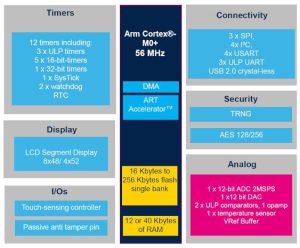
Called STM32U0, the “MCUs can reduce energy consumption by up to 50% compared to previous product generations”, said the company. It “allows more designs to go battery-free, running solely from an energy-harvesting system such as a small photovoltaic cell”.
On the same day, ST announced future FD-SoI MCUs with phase-change memory
Picking the STM32U083xC at random, they run from 1.71 to 3.6V and consume 130nA in battery-backed mode with the real-time clock and nine 32bit registers sustained.
Run mode costs 52μA/MHz according to the front page of the data sheet, which goes on to say that in shut-down, with six wake-up pins active, this can drop to 16nA, increasing to 30nA in stand-by (8kbyte ram retained) with the same wake pins, or 160nA if the RTC is sustained as well. The lowest power Stop mode costs 695nA (825nA with RTC). Wake is in 4μs from the highest drain Stop mode.
Power consumption is aided by having two on-board linear regulators, one for running up to 56MHz, and a low power regulator for running at up to 2MHz – a low-power run mode.
Clock sources abound, including a crystal option and adjustable RC-clocks for fine-grained power consumption tuning.
Near 67DMIPS is possible at 56MHz thanks to 64bit flash and an accelerator which implements an instruction pre-fetch queue and branch cache, said ST, adding: “The performance achieved thanks to the ART accelerator is equivalent to 0 wait state program execution from flash memory at a CPU frequency up to 56 MHz.”
Security
The company has taken security seriously: “STM32U0 devices are the first MCUs running on Arm Cortex-M0+ targeting SESIP Level 3 and PSA level 1 focusing on firmware code protection. Certification provides an independent assurance that product manufacturers can leverage to comply with the coming voluntary US Cyber Trust Mark and mandatory EU Radio Equipment Directive [RED].”
For user interface, multiple capacitive sensing channels are included in some devices, as is an LCD controller for 8×48 or 4×52 segment displays that includes a step-up converter.
Operation is across -40 to +85°C (+105°C junction), or -40 to +125°C (+130°C junction).
Analog peripherals include ADCs, DACs, operational amplifiers (with programmable gain amplifiers) and analog comparators – both the op-amp and the comparators have rail-to-rail inputs.
Aside from the RTC, the superset of timers is: 1x general-purpose 32bit, 1x 16bit PWM dedicated to motor control, 3x general-purpose 16bit and 3x 16bit low-power.
Flash options up to 256kbyte are available, and packages up to 81pads.
There are three parts to the STM32U0 family:
| STM32U0… | Flash (kbyte) | Ram (kbyte) | LCD segment controller |
crystal-less USB 2.0 (device) |
Comparator | Timers with input capture |
UART | AES 128/256 |
| STM32U031 | 16 – 64 | 12 | 1 | 2 | 1 | |||
| STM32U073 | 64 – 256 | 40 | Y | Y | 2 | 3 | 2 | |
| STM32U083 | 256 | 40 | Y | Y | 2 | 3 | 2 | Y |
Find the STM32U083xC data sheet here, with detailed power consumption figures from page 48 for the next nine pages – ST has been nothing if not thorough. Delving into these, 52μA/MHz is at 48MHz 25°C from 1.8V running a benchmark labelled ‘While’.